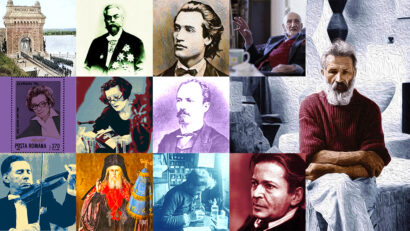The History of a Troublesome Neighborhood: Ferentari
Considered nowadays a troublesome district from the social and economic points of view, the district of Ferentari wasnt always known as that

Christine Leșcu, 09.07.2023, 14:00
The history of this area has been recently brought to light through a book entitled ‘Ferentari Incomplete, coordinated by Andrei Razvan Voinea, Dana Dolghin and Gergely Pulay. The development of this ill-famed district starts in the period between the two world wars, when Ferentari lied on the outskirts of Bucharest. Lets find out more from historian Andrei Razvan Voinea:
The development of the Ferentari district started off on the wrong foot, so to say, because it was built around Ferentari Road, a road leading nowhere. It started in Calea Rahovei and ended up in an empty field, where there were the vineyards of the metropolitan bishopric and other monasteries. These plots of land were eventually divided up and gradually a lot of houses cropped up, turning the district into a residential area, more or less formal. The small rents here attracted a lot of workers, mainly those working in the Bucharests first real industrial area, at Filaret Hill. And this is how the districts development kicked off back then. Its development was agonizingly slow, and until 1940, the district was known as Happy Field, because the former vineyards here had turned into pubs. At a certain time, there were close to one hundred pubs in the area, and one of the streets was known as Happy Street. For this reason this part of Bucharest wasnt referred to as a district. It was known as Happy Field, and until 1940 it was completely underdeveloped, ignored by the central authorities, without sewerage, running water and the likes.
Besides poor workers, small businesses started to appear in Ferentari between the two world wars. Some of the few well off here managed to build better houses, even villas in some areas, but these were quite few in number.
Here is historian Andrei Răzvan Voinea at the microphone again:
“There were several small businesses in Ferentari. One such business was the one belonging to a Jewish entrepreneur called Littman, who in 1935 hired architect Paul Rossini to design this beautiful modern house in a style which used to be very much en vogue in Europe at the time. This is one of the few examples of beautiful villas in the aforementioned district. Another one is Villa Coca, located at number 43 on the same Happy Street, which also boasts a very warm, balanced architecture. Unfortunately, the entrepreneur Littman fell victim to the Iron Guard rebellion, which also affected Ferentari.
However, it was the communist regime that followed which kicked off a real process aimed at streamlining the district in an attempt to offer decent life conditions to workers. And they managed to achieve this goal to a certain extent.
Blocks of flats were built out of bricks in a vacant area here, and are known to this day as the Red Blocks of Flats. Here is Andrei Răzvan Voinea again:
“New blocks of flats were to be built on this vacant place, bought by the Public Servant Institute around 1946. The plot was taken over by city hall two years later, and the construction of a very functional housing project consisting of 20 blocks of flats commenced. The architect was called Gheorghe Popov, and the communists basically invented a kind of communal living. It is a space that is conceived totally differently from the model of home lots and individual gardens arranged horizontally. This was vertical development. These are blocks of flats with four stories, with green spaces in between, and lots of social services. There were 20 apartment buildings, with about 30 families each, so about 600 families moved there. The buildings had their own hot water plants, close by they had a kindergarten and a cinema theater. When the buildings were finished, they built a swimming pool, which was open until right after 1990. Right as you turned onto Ferentari Road you had all sorts of shops, as well as a barber shop. It was a sort of self-managed small town.
Things started going downhill, however, around the mid-1960s, and got gradually worse to this day. The explanation as to why is supplied by historian Andrei Razvan Voinea:
“What happened after 1966? The communists, after building the red blocks, don’t do much. They built a school, somewhere on the fringe. They also build a main sewage line for this entire segment, and set up street lighting. These are not major works, they are just regular interventions. A city plan was issued in 1966 for the entire area. These were the city limits, and in 1966 they came up with a very serious plan designed by the Project Bucharest Institute, with blocks of flats being part of the project. This involved razing the rural area of houses on the city edges, to be replaced by apartment buildings. They took great care to begin this project of urban renewal on empty lots. Even though they were planning to raze everything to the ground and build apartment buildings all along Ferentari Road, somehow these blocks were built only in certain isles, which did not face the road directly, but were behind ground houses, even though they had all the proper infrastructure, such as heating, street lighting, and so on. There was an additional project, that of making buildings with smaller size apartments, such as single room units. They stuck to this type of city limit neighborhood, aimed at industrial workers, who come to Bucharest for work, make a family, and then move to another place. Again, Ferentari holds on to this feature, that of an interstitial, transit type of area. However, the project was abandoned. More apartment building isles were erected, in total over 150 single room apartment buildings, or two room apartment buildings, mostly inhabited by workers from the Vulcan factory. After these isles were built, the project was simply abandoned, and then national legislation was changed in 1973. It was a mess.
After the major earthquake of 1977, a complex urban plan was conceived, but unfortunately almost nothing was done until the regime fell in 1989. This was followed by the chaotic transition of the 1990s, during which the authorities neglected the neighborhood, leading to a degradation of social conditions.
(bill & CC)






























